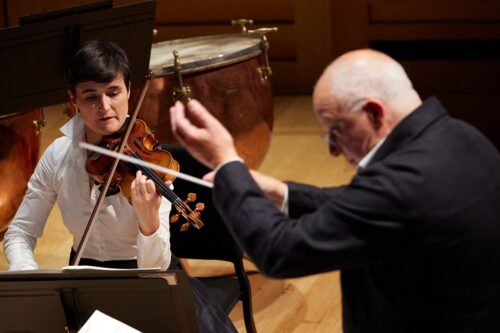 United Kingdom Vaughan Williams, Smyth, Grime, Haydn: Julian Bliss (clarinet), Bath Festival Orchestra / Peter Manning (conductor). Kings Place, London, 18.10.2021. (CC)
United Kingdom Vaughan Williams, Smyth, Grime, Haydn: Julian Bliss (clarinet), Bath Festival Orchestra / Peter Manning (conductor). Kings Place, London, 18.10.2021. (CC)

Vaughan Williams – Two Hymn Tune Preludes (1936)
Ethel Smyth – Serenade in D (1889)
Helen Grime – Clarinet Concerto (2009)
Haydn – Symphony No.104 in D, ‘London’ (1795)
The Bath Festival Orchestra was originally founded in 1959 by Yehudi Menuhin, at the time the Artistic Director of the Bath Festival (their most famous recordings are probably those of Bach with Dame Janet Baker). The orchestra was relaunched during the COVID pandemic with the intent of creating a sustainable environment for classical music. The Bath FO is professional and comprises young musicians, with the aim of widening the envelope via outreach work to diverse communities where classical music is often overlooked. Although not on display at this concert, the Bath FO also has a pronounced interest in innovation in enhanced live performance, including augmented reality, virtual reality and hologram technology.
The concert began at 8pm for some reason: it was a full-length concert which meant a rather late 10.15pm close.
Vaughan Williams’s Two Hymn Tune Preludes was a beautiful opener. The two hymn tunes in question are: ‘Eventide Hymn’ by William Henry Monk, (famous for its use at sports events including the Olympics) and ‘Dominus regit me’ (‘The King of Love my shepherd is’) by J B Dykes There are lovely solos, particularly for the leader (Maren Bosma), oboe (Polly Bartlett) and cello (Nina Keva).
The Serenade in D was Erhel Smyth’s first major orchestral work and was premiered by the Crystal Palace orchestra. If any piece fulfils its remit as serenade (as opposed to more formally constructed symphony or sonata), this one does. It breathes a fresh air, occasionally unsettled harmonically but always prevailing. Here, the Bath FO’s antiphonal layout really paid dividends; plenty of energy to the performance, too. The second movement Scherzo is fascinating: more like a reel, perhaps, with a skipping figure that is most infectious, taken here at what sounded like a Presto (the marking is actually Allegro vivace). The conductor, Peter Manning, judged Kings Place’s tricky acoustic well, As befits a serenade, there is no profound slow movement; instead, a playful Allegretto stands in its stead, with lovely woodwind contributions (particularly from Luke English on clarinet) while the finale (Allegro con brio) found the Bath strings in fine fettle, negotiating the trickier moments well; but it was the points at which Smyth introduces lyricism that were so lovely and, indeed, memorable. Nice to hear some raucous clarinets through the textures, too. A lovely piece, lovingly performed.
Helen Grime’s Clarinet Concerto is remarkably multivalent, and in Julian Bliss’s performance this piece emerged as the clear highlight of the programme. Bliss himself describes the piece as ‘challenging’ in the concert’s accompanying podcast. Originally inspired in mood by La Cloche fêlée (The Cracked Bell) by Baudelaire, as the work progressed it moved further away from that point. The score requires quicksilver reactions from the players. Scored for an intimate ensemble (including harp), it is remarkable how Grime’s harmonies are so glowing. The angular lines of the solo part bristle with energy (particularly in Bliss’s fine performance) while the longer melodies of the central ‘Free and Enigmatic’ spoke directly to the heart. Throughout, a double bass grounds the sound whenever it is used; passages of the second movement, for example, float in the ether without it. The finale was virtuosic from all concerned, the often-glacial textures most effectively delivered.
The Haydn’s London Symphony was more problematical: there was a good old-fashioned, ponderous eight-to-a-bar slow introduction to the first movement and an Andante that was rather low on charm. It did rather come across that rehearsal time had been spent on the Smyth and the Grime, resulting in a rather workaday performance that often felt quite cold. Some of the tuning was rather suspect, too; but against that was an excellent low, rustic pedal point at the outset of the finale.
Beyond doubt, though, the concert was certainly worth it for the Grime and the Smyth.
Colin Clarke
